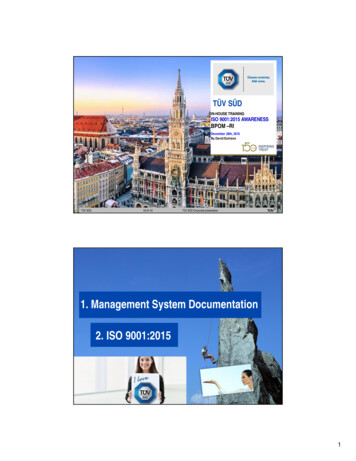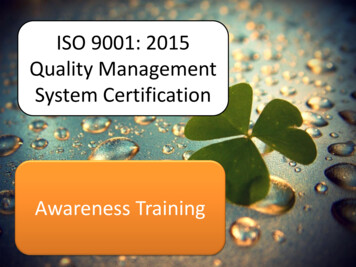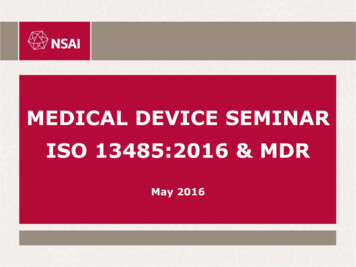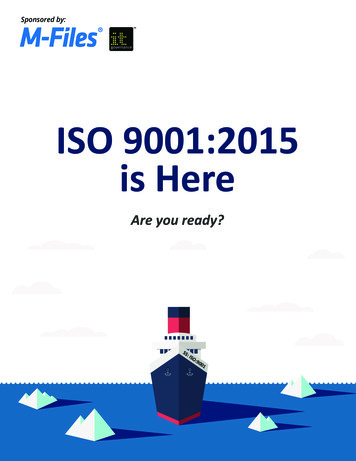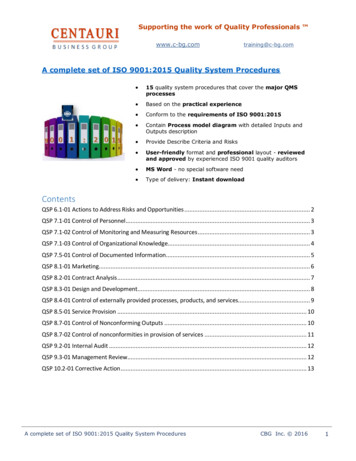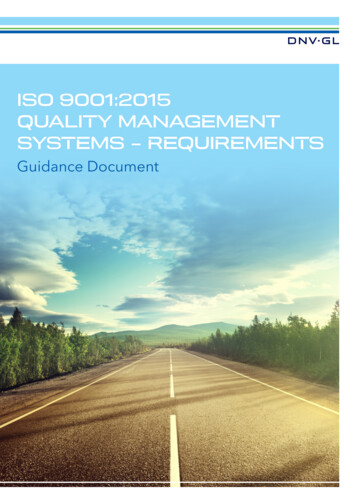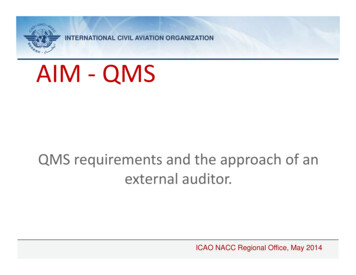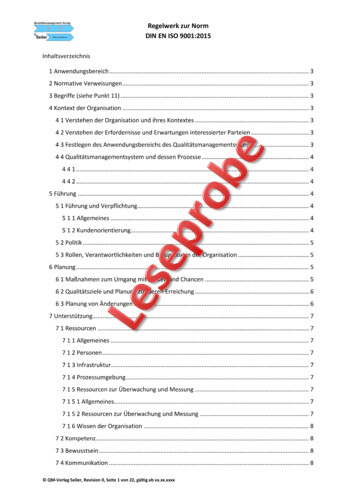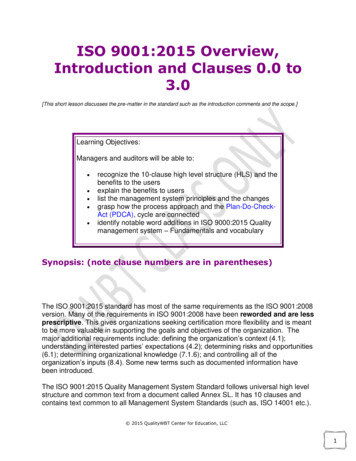
Transcription
ISO 9001:2015 Overview,Introduction and Clauses 0.0 to3.0[This short lesson discusses the pre-matter in the standard such as the introduction comments and the scope.]Learning Objectives:Managers and auditors will be able to: recognize the 10-clause high level structure (HLS) and thebenefits to the usersexplain the benefits to userslist the management system principles and the changesgrasp how the process approach and the Plan-Do-CheckAct (PDCA), cycle are connectedidentify notable word additions in ISO 9000:2015 Qualitymanagement system – Fundamentals and vocabularySynopsis: (note clause numbers are in parentheses)The ISO 9001:2015 standard has most of the same requirements as the ISO 9001:2008version. Many of the requirements in ISO 9001:2008 have been reworded and are lessprescriptive. This gives organizations seeking certification more flexibility and is meantto be more valuable in supporting the goals and objectives of the organization. Themajor additional requirements include: defining the organization’s context (4.1);understanding interested parties’ expectations (4.2); determining risks and opportunities(6.1); determining organizational knowledge (7.1.6); and controlling all of theorganization’s inputs (8.4). Some new terms such as documented information havebeen introduced.The ISO 9001:2015 Quality Management System Standard follows universal high levelstructure and common text from a document called Annex SL. It has 10 clauses andcontains text common to all Management System Standards (such as, ISO 14001 etc.). 2015 QualityWBT Center for Education, LLC1
The review format for this class is to present the requirements and rationale supportedby explanation, discussion and examples. New requirements and important pointsare marked with bold text. A checklist has been provided (see Class Links) that youcan use to make notes and later use to conduct an audit or to implement the newrequirements. 2015 QualityWBT Center for Education, LLCISO 9001 High Level Structure (HLS)ISO 9001:2015 has 10 clauses. The 10 clauses represent the common HLS for allmanagement system standards. Clauses 4-10 contain "shall" requirements.1. Scope (i.e. area or boundaries)2. Normative references (i.e. necessary additional documents)3. Terms and definitions4. Context of the organization (i.e. an organizational profile)5. Leadership6. Planning7. Support8. Operation9. Performance evaluation10. ImprovementAnnex A (Clarification of new structure, terminology and concepts)Annex B (Other quality related standards)BibliographyThere was no particular plan regarding how the 10 clauses were organized, but itstill follows the PDCA cycle. Some sub-clauses of the HLS are required while othersare added by individual ISO groups that are developing a standard. Typically, clause 8is very specific to the area covered by the standard such as quality (ISO 9001),business continuity (ISO 27001), and environmental management (ISO 14001).As a model, it could resemble the figure on the next page showing the qualitymanagement system (QMS) processes. 2015 QualityWBT Center for Education, LLC 2015 QualityWBT Center for Education, LLC2
ISO 9001 High Level Structure(HLS) -ContinuedAs a model, it could resemble the figure below showing the quality management system(QMS) processes.In the model, the context of the organization relates to overall system actions, theleadership and support would be planning, the doing is in operations,the checking takes place under performance evaluation, and finally, acting on theevaluation results would be where improvement takes place. 2015 QualityWBT Center for Education, LLCISO 9001 High LevelStructure (HLS) -ContinuedCompared to quality award criteriaThe QMS structure is new, but resembles other national quality awardstructures such as the American Malcolm Baldrige National Quality Award (MBNQA).ISO 9001:2015 QMS Clause TitlesMBNQA Criteria for performance excellence 4.1 Organization and its context Organization profile 5 Leadership Leadership 5.1.2 Customer focus Customer focus 6 Planning Strategic planning 7.1 Resources Workforce focus 8 Operation Operation focus 9 Performance evaluation Measurement, analysis and knowledgemanagement 10 Improvement Results 2015 QualityWBT Center for Education, LLC3
The criteria for ISO 9001:2015 and the MBNQA share many commonelements. Some of the common criteria are: organization profile/context; leadership;planning; customer focus; measurement analysis and knowledge management;operational focus; and results. The MBNQA criteria claims to be less structured andvery flexible, but many notes have been added to the criteria to provide additionalguidance. The ISO 9001 Quality Management System (QMS) is structured and perhapsprovides a more systematic and guided approach to improving performance andmeeting objectives.The performance focus for ISO 9001:2015 goes beyond improving theeffectiveness of the QMS. Improvement actions are still limited to the scope of theQMS, but meeting organizational objectives relative to the QMS elements is included.This means that it is okay for an organization to have an objective to improve the QMSefficiency, such reducing defects, but perhaps not improving the efficiency of accountingdepartment reporting, if that accounting process is not part of the QMS scope. 2015 QualityWBT Center for Education, LLCISO 9001 Common TextAuditing clauses 4, 5, 6, 7, 9 and 10 will be the same or similar for all managementsystem standards. The clauses contain common text from a document titled AnnexSL. (See explanation below) The intent is for all management system standards tocontain the same common text for similar clauses such as document control, correctiveaction, control of resources, and so on. The common text and high level structure willmake it easier to audit and implement various management systems such as quality,safety and environmental. Like cupcakes, audit clauses have the same structure andsome common ingredients, but can vary in details.Auditors and managers should note, the different management system standardswill contain the same common text, but the individual standard groups such asquality or environmental were allowed to add text. The added text may provide anexplanation or provide additional requirements.Sidebar: Annex SL common structure and textAnnex SL is controlled by a high level International Organizationfor Standardization committee. The annex is available to the 2015 QualityWBT Center for Education, LLC4
public, but submerged in an ISO directive (ISO/IEC Directive, Part1 Consolidated ISO Supplement). Annex SL provides the basis fora generic management system by providing guidance for highlevel structure and common text. The objective was to makeimplementing multiple management system standards mucheasier and eliminate redundancy. 2015 QualityWBT Center for Education, LLCISO 9001 StandardIntroductionThe ISO 9001 introduction includes explanations, but no requirements to be auditedagainst. In this class, we will provide a brief outline of the introduction since it does notcontain requirements. However, the introduction is educational and we recommend thatyou read and study its content.0.1 GeneralPotential benefits of implementing this standard include: the ability of an organization to consistently provide products and servicesthat meet customer and applicable statutory and regulatory requirementsfacilitating opportunities to enhance customer satisfactionidentification of organization risks and opportunities that need to be addressed(new)the ability of the organization to demonstrate conformity to specified qualitymanagement system requirements by QMS certification or other meansThe standard is not intended: to require organizations to align their documentation to the clausestructure of this international standardto require organizations to use the specific terminology of this internationalstandard such as documented information to replace documents and records orcontrol of externally provided process, products and services to replace thepurchasing department title. 2015 QualityWBT Center for Education, LLC5
Though the standard does not list the high level structure and common text as a benefitin clause 0.1, it will make integrating with other management standards easier andpossibly provide more stability and fewer clause numbering changes in the future.Auditors should not force management systems standards lingo on auditeeorganizations. For example: “Documented information” to replace “documents andrecords” or “control of external providers” to replace “purchasing.”The standard content and design incorporates the following: the process approach embodying PDCA cycleuse of risk-based thinking to determine the factors possibly causing itsprocesses and its QMS to deviate from planned results (objectives)the concept that organizations should improveuse of the word “shall” indicating a requirementThe ISO 9001 was originally designed to be a baseline standard for assurance ofquality. Over the last decade the controls have expanded to include more progressivetechniques assure customer requirements are met. These include: process approach,risk-based thinking, PDCA and more flexible open-ended requirements. This hascaused some descent in some of the compliance sectors that favor more prescriptiveverifiable controls. 2015 QualityWBT Center for Education, LLC0.2 Quality managementprinciplesThis international standard is based on the quality management principles described inISO 9000:2015. The quality management principles have been modified to better alignwith an organization’s needs. The quality management principles are very important,but cannot be the reference for a nonconformity. The principles are conceptual innature and should be implemented at the highest levels in an organization, andpermeate the processes and operations as well.The quality management principles for a quality management system (QMS) are: 2015 QualityWBT Center for Education, LLC6
1. customer focus2. leadership3. engagement of people4. process approach5. improvement6. evidence-based decision making7. relationship managementThe main changes to the quality management principles are: involvement of people is now “engagement of people.” The concept has notchanged.the system approach (previously # 5) has been combined with process approach.The concept has not changed.improvement has replaced “continual improvement” in that all kinds ofimprovement are essential to maintain organizational performance. The concepthas not changed.evidence based decision making replaced factual approach to decision making.The statement is stronger and more focused. The concept has not changed.relationship management has replaced mutually beneficial supplier relationships.The principle is much broader to include all interested parties and is morecomprehensive.The ISO 9001 standard embodies the quality management principles. 2015 QualityWBT Center for Education, LLC7
2015 QualityWBT Center for Education, LLC0.3 Process approach0.3.1 GeneralThe process approach enables organizations to control the interactions amongthe processes of their system, so intended results can be achieved in accordance withthe quality policy and strategic direction of the organization.The standard “promotes the adoption of a process approach when developing,implementing and improving the effectiveness of a quality management system”.(clause 0.3.1). This means that the very architecture of a quality management systemshould be constructed around the key business processes of the organization, and 2015 QualityWBT Center for Education, LLC8
not the requirements of ISO 9001. When creating a system, begin by determining keyprocesses (through flowcharts, SIPOC diagrams or other means) and then createappropriate management controls that are based on the requirements of the ISO 9001,customers, regulators and risk based thinking. Only by considering key businessprocesses and the objectives for their outputs, can a quality management systemfulfill its promise of true quality management.Management of the processes and the system can be achieved using the PDCA cyclewith a focus on risk-based thinking aimed at taking advantage of opportunities andpreventing undesirable results. 2015 QualityWBT Center for Education, LLC0.3.3 Risk-based thinkingThe concept of risk-based thinking has been implied in previous editions of thisinternational standard including, for example, 1) carrying out preventive action toeliminate potential nonconformities, and 2)analyzing occurring nonconformities andtaking action to prevent recurrence. Also, consider the age-old requirement in themanagement review clause that the organization assess “the suitability andeffectiveness” of their quality management system. Does one know that their system issuitable and effective simply because it meets the requirements of ISO 9001? Thatmay be one measure but suitability and effectiveness means much more. It means howwell the system identifies and manages risks to product and service quality andcustomer satisfaction.An organization needs to plan and implement actions to address risks and opportunities(clause 6.1).Addressing both risks and opportunities establishes a basis forincreasing the effectiveness of the QMS, achieving improved results and avoidingnegative effects.Risk-based thinking is the key to creating a suitable and effective quality managementsystem where there is an absence of ISO 9001 requirements. For example, ISO 9001might require that organizations implement suitable product inspections at appropriatepoints during manufacturing. What does that mean? How does an organization dothat properly? It is only by understanding what risks exist in processes(manufacturing or service) that an organization can implement appropriatecontrols. Risk-based thinking helps us decide where controls are needed andhow simple or sophisticated those controls need to be. 2015 QualityWBT Center for Education, LLC9
Opportunities can arise as a result of a situation favorable to achieving anintended result. For example, a set of circumstances allowing the organization toattract new customers, develop new products and services, reduce waste, or improveproductivity. An opportunity is not the opposite of risk. Perhaps it is like thedifference between being able to stay on the plotted course versus finding a short cut toyour destination. 2015 QualityWBT Center for Education, LLC0.4 Relationship with othermanagement systemstandardsAnnex B provides details of International Standards on quality management and qualitymanagement systems developed by ISO/TC 176.A matrix showing the correlation between the clauses of this edition of this internationalstandard and the previous edition (ISO 9001:2008) can be found on the ISO/TC 176/SC2 open access web site.There can be two types of management system standards. There are requirementstandards, such as ISO 9001 and ISO 14001, that use the word shall to indicaterequirements that can be audited against for certification purposes. Most otherstandards are guideline standards, such as ISO 9004 and ISO 19001, that use theword should or may to indicate guidance for users of the standard. 2015 QualityWBT Center for Education, LLC1 Scope 2015 QualityWBT Center for Education, LLC10
An organization would use the ISO 9001 standard when it wants to demonstrateconformity to a formal QMS, aim to enhance customer satisfaction, and/or assureconformity to customer and applicable statutory and regulatory requirements.All the requirements of the standard are generic and are intended to be applicable toany organization, regardless of its type or size, or the products and services it provides.An important note is the terms “product” or “service” only applies to products andservices intended for, or required by, a customer. This information may be helpfulin discussions regarding disposables, recyclables, sludge and secondary or spin-offproducts.Sidebar: Question?Does this mean that internal, “back office” processes may not besubject to QMS controls because they are not provided to acustomer? I’m not too clear on this. If interested, click here for thediscussion.2 Normative referencesNormative references are indispensable for the implementation and application of theQMS standard. The only normative reference listed is the ISO 9000:2015, Qualitymanagement systems — Fundamentals and vocabulary standard.It is recommended that all users of the ISO 9001:2015 purchase or have availablethe ISO 9000:2015 vocabulary standard. 2015 QualityWBT Center for Education, LLC3 Terms and definitionsThe ISO 9000:2015 has approximately 62 new word definitions compared to the 2005version. The design of this class includes hyperlinks to the definitions of words asneeded to explain requirements of the quality management international standard. Youdon't need the ISO 9000 standard for this class but it is recommend for users. 2015 QualityWBT Center for Education, LLC11
2015 QualityWBT Center for Education, LLCCongratulations! 2015 QualityWBT Center for Education, LLC12
System and LeadershipRequirements, Clauses 4-6[This medium length lesson discusses the overall management system and leadership requirements.]Learning Objectives:Upon completion of this training, managers and auditors will beable to: explain the changed requirementsidentify the new clauses added to the standardPlease note that we will be discussing clauses 4, 5 and 6, see orange blocks. 2015 QualityWBT Center for Education, LLC13
Synopsis:Clauses 4, 5, and 6 represent the system requirements and planning/leadership aspectsof the PDCA cycle. You may consider these areas as administrative. An auditorwill look for many of the system-leadership-planning requirements to bedemonstrated as part of the overall audit. These clauses include newrequirements for understanding the context of the organization, establishing linksto interested parties, demonstrating leadership, and identification of risks andopportunities.The review format for this class is to present the requirements and rationale supportedby explanation, discussion and examples. New requirements and important phrasesare marked with bold text. A checklist has been provided (see Class Links) that youcan use to make notes and later use to conduct an audit or to implement the newrequirements. 2015 QualityWBT Center for Education, LLC4.0 Context of the organization4.1 Understanding theorganization and its contextThe standard states the organization must determine external and internal issuesrelevant to the organization's purpose and strategic direction and that affect itsability to achieve intended results.The word “context” is used instead of “organizational environment” because it is to useto address both external and external factors. Another common term for this is a profile,as in determine the organization's profile.The first requirement of the standard is to ask organizations to examine and understandthe fundamentals of what business they are in, such as: the products/services they providethe customers for those products/servicesthe competitive landscapethe ability to raise capital and sell their products 2015 QualityWBT Center for Education, LLC14
What is the organization’s purpose? What business is it in? What market(s) will itpursue? For example: Is a mobile phone manufacturer in the business of building hardware or providingtelecommunications services?Will that mobile phone maker market their phones to business people,teenagers?Is mobile telecommunications regulated by the government?Only after the organization frames itself in terms of why it exists and whatmarkets it serves can it properly design and implement a quality managementsystem suitable for its purpose. 2015 QualityWBT Center for Education, LLC4.1 Understanding theorganization and its contextcontinuedMonitor and review information about these issues for consideration.Issues can include positive and negative factors or conditions.Consider issues arising from: legal, technological, competitive, market, cultural, social, economics at all levelscompany values, culture, knowledge, performance 2015 QualityWBT Center for Education, LLC 2015 QualityWBT Center for Education, LLC15
4.1 Understanding theorganization and its contextcontinuedOrganizations can list important issues that need monitoring. For an example see tablebelow (listing important issues, as well as who would do the monitoring and what kindsof information that would be collected):Monitoring important issuesImportant issueWho wouldmonitorWhat information could bemonitoredLocal pool of availableworkersHR DepartmentLocal unemployment rate, graduatingclasses at local colleges and trainingcentersLocal zoning and taxpoliciesFinancialDepartmentCity council resolutions, annualbudgetsAvailability of technologyEngineeringDepartmentTrade publications, trade showsMarketplaceMarketingDepartmentConsumer Price Index, consumerbuying trends, introduction ofcompeting productsWorker skills, trainingHR DepartmentRetirements/succession planning,progression through “job grades”Changes inregulations/codesRisk & QualityDepartmentControl of external documents fromregulators, Monitor sector news 2015 QualityWBT Center for Education, LLC 2015 QualityWBT Center for Education, LLC16
4.1 Understanding theorganization and its contextcontinued4.1 Explanation and discussionStakeholders (an interested party) are those that influence the organization’s work. Theorganization is already in contact with these stakeholders such as:Possible StakeholdersRegulatorsTrade/professional associationsGovernment agenciesProperty ownersTrade unionsSponsorsBoard of directorsBusiness partnersInvestorsLenders/banksThis list of persons/organizations represents sources where the organization oran auditor would expect to find “external issues.” The reason for identifyingstakeholders is to provide an input into the risk assessment (clause6.1). Documentation, which will show that stakeholders have been considered, can bepart of the risk assessment addressed in clause 6.1. 2015 QualityWBT Center for Education, LLC.2 Understanding the needs andexpectations of interested parties 2015 QualityWBT Center for Education, LLC17
Determine the interested parties relevant to the QMS and the requirements ofthose parties.Monitor and review the information about these parties and their relevantrequirements.Consider the following examples: direct customersend userssuppliers, distributors retailers or others involved in the supply chainregulators and othersOkay, now organizations must name interested parties and monitor them. How manydo they need to monitor? 2015 QualityWBT Center for Education, LLC4.2 Explanation and discussionOrganizations and stakeholders have a relationship that includes needs andexpectations of each other. the Board of Directors expects the company to make a profita regulator expects compliance with regulationsan organization may expect its trade association to lobby on its behalfan organization expects its suppliers to deliver a quality product on timeengineers are expected to use design standardsthe organization could also voluntarily subscribe to policies of socialresponsibility, codes of ethics, anti-bribery, and employee welfare.The number of stakeholders reflects the complexity of the business/organization.The output of this process is an input to the risk assessment (Clause 6.1) and isdocumented there.The key is to understand relevant requirements for product/service quality andcustomer satisfaction. Although ISO 9001 requires that an organization understand theneeds and expectations of relevant interested parties, organizations are not requiredto be bound by them. An environmental group might be interested in the conduct of anoil company, but that oil company is not bound to meet the needs of that particularinterested party. 2015 QualityWBT Center for Education, LLC18
2015 QualityWBT Center for Education, LLC4.3 Determining the scope of thequality managementsystem (2008 version 4.1General requirements)Most of the requirements in this clause are similar to clause 4.1 of the 2008 version.The requirements are more descriptive (open-ended) versus prescriptive (closedended). Note, italic text is not in the standard.When determining this scope, the organization must consider:a) the external and internal issues referred to in 4.1 (strengths,weaknesses, opportunities, threats)b) the requirements of relevant interested parties referred to in4.2 (relationships: employees, unions, board of directors, customers,suppliers, shareholders, media, local community, government officials,financial organizations, special interest groups, and so on)c) the products and services of the organization (products:manufacture, storage, safeguarding, delivery, maintenance, warranty,disposal, replacement; service: performance or delivery, products used,repeating service, qualification-certification, and so on.)There is no requirement for a record or retained documented information(DI) that a, b, and c were considered. As an auditor, you may seekdocumentation that a, b and c were considered or interview a person who isresponsible for review and approval of the scope and then ask about a, band c. There is no, “if appropriate” qualification for this requirement. Thismeans an organization cannot select which are appropriate, they mustconsider each of those three requirements when determining thescope. If it makes more sense to you, use the word “factors.” As in thepicture, the organization must establish boundaries.No quality manual is required. However, the scope must be maintainedas DI. The scope must include justification for requirements that cannot 2015 QualityWBT Center for Education, LLC19
be applied and/or determined to be “not applicable.” All requirementsare assumed to be applicable to an organization’s QMS unless identified asnot applicable. Note that the standard refers to individual requirements, andnot entire clauses that may be applicable or not applicable. Therefore anyparticular requirement within a clause could be not applicable.Conformity to ISO 9001:2015 may be claimed only if the requirementsdetermined as not being applicable do not affect the organization’s ability orresponsibility to ensure the conformity of its products/services andenhancement of customer satisfaction. You should note this is ISO9001guidance using the word "may" instead of shall.Sidebar: Code“Maintained DI” is the code for a document that must be underdocument control. Also, “retained DI” is the code for keeping arecord.Remember there are more details in the checklist found in Class Links. 2015 QualityWBT Center for Education, LLC4.4 Quality management systemand its processes (2008 version4.1-General requirements)4.4.1ISO 9001:2015 places a major emphasis on processes. Auditors need a strong grasp ofthe dynamics and a fundamental understanding of what constitutes a process.The organization must determine the processes needed for the QMS and theirapplication throughout the organization. The organization must (new requirements inbold):a) determine the inputs required and the outputs expected from theseprocessesb) determine the sequence and interaction of these processes 2015 QualityWBT Center for Education, LLC20
c) determine and apply the criteria and methods (including monitoring,measurements and related performance indicators) needed to ensurethe effective operation and control of these processesd) determine the resources needed for these processes and ensure theiravailabilitye) assign the responsibilities and authorities for these processesf) address the risks and opportunities as determined in accordance with therequirements of 6.1g) evaluate these processes and implement any changes needed to ensure thatthese processes achieve their intended resultsh) improve the processes and the quality management systemThe requirement to assign responsibilities and authorities for each process is a goodaddition to the new standard and is an auditable requirement. Now the organizationneeds performance indicators such as metrics, to measure and monitor performance.Verify the interaction of processes was determined in some manner. Many of therequirements will be verified during the audit.Sidebar: Process listThis is a great list (a-h) to keep with you when each process isimplemented, evaluated or audited. 2015 QualityWBT Center for Education, LLC4.4.2 (2008 version 4.2.1dGeneral requirements)To the extent necessary the organization must maintain DI (controlled documentssuch as procedures etc.) to support operations and its processes.To the extent necessary the organization must retain DI (records) to haveconfidence that the processes are being carried out as planned.This is the catch all clause for auditors to cite if an organization does not have sufficientdocuments (plans) to control a process or necessary records to verify outputs. 2015 QualityWBT Center for Education, LLC21
ISO 9001 allows documented information to be in any medium or format. This includespaper, electronic documents and records on computer servers, hyper-text, etc.The requirements are similar to the 2008 version except the requirements are openended. No specific procedures, or plans are required by the standard.Sidebar: Support versus control commentStandards establish rules (controls) to lower risk to assureoutputs. Organizations must maintain DI that controls operationsand its processes as well as support them.Sidebar: Maintained vs RetainedThere is no requirement for an organization to change itsterminology from documents and records to documentedinformation (DI). In fact, world organizations, governments andlegal systems understand what it means to have a record butwould not understand what retained DI means. 2015 QualityWBT Center for Educati
ISO 9001 Standard Introduction The ISO 9001 introduction includes explanations, but no requirements to be audited against. In this class, we will provide a brief outline of the introduction since it does not contain requirements. However, the introduction is educational and we r


